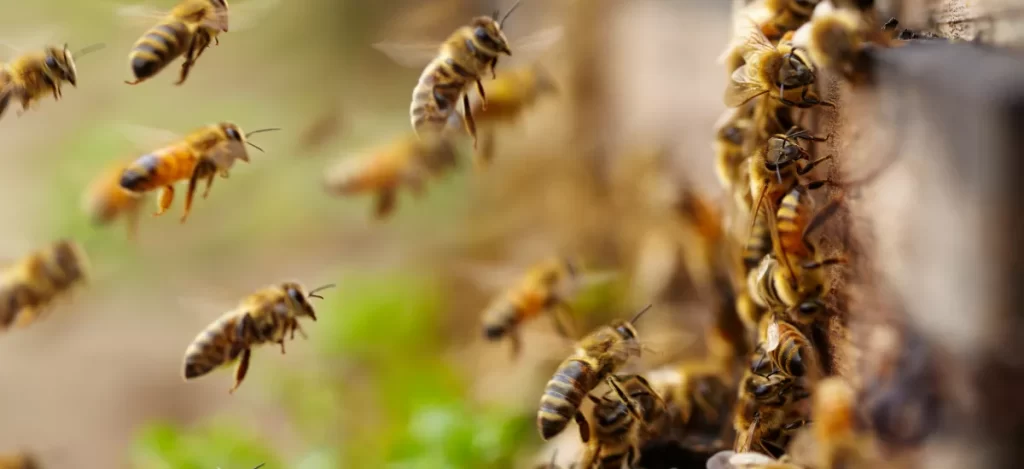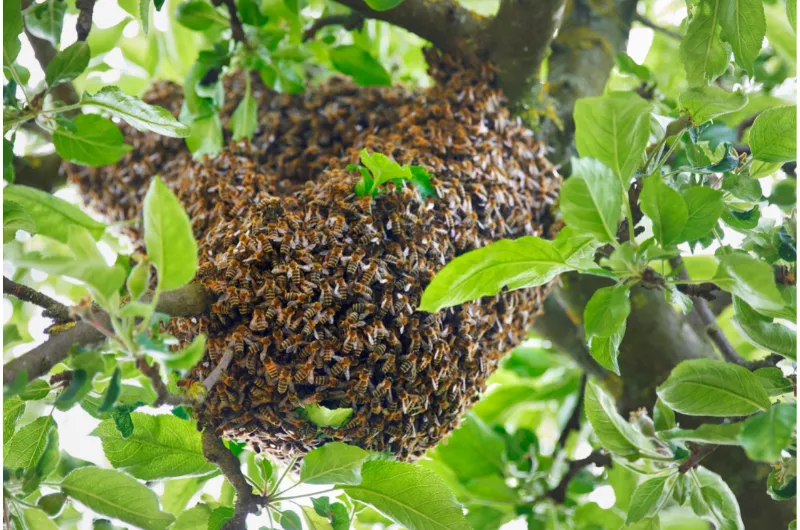With new beekeepers entering the craft every day, this is an important question to answer. After all, you don’t want to disturb the “flow” of your colony too much! Hopefully this article has provided some interesting information about the secret life of bees and may even (hopefully) help you learn more about your own bees.

Bees often get up to work at sunrise, when their habitat is still damp and the flowers still have wet pollen. This is common among foragers as they seek out pollen and nectar. Meanwhile, most of the other bees working in the hive have no set sleep pattern.
In case you didn’t know, there are different types of bees in a hive, so some tend to work different hours than others. Since foraging bees can only see clearly in good light, they usually work tirelessly from sunrise to sunset.
Read the article: Do Bees Sleep? Do Bees Sleep In Flowers?
Why You Should Follow A Bees Work Schedule?
Most people don’t think twice about seeing a bee fly by, but there’s a lot going on underneath those little fluffy bodies we’re not necessarily familiar with. You don’t want to be surprised by the colony in your hive, so it’s best to understand and address bee “off days” to increase your productivity. As beekeepers, this is an important part of our job!
Knowing these “off-peak” times allows you to do more of the main work on your hives during these times to minimize your impact on bees and the comfort of your home. I know it’s not always possible for busy beekeepers, but it’s definitely something to watch out for.
Bees are known for being hardworking, so you’d think they’re always busy. Yes, they are busy pollinating plants and providing us with honey and beeswax, but you might be surprised to learn that bees actually have some downtime.
Read the article: How To Start Beekeeping? (A Complete Guide To Beekeeping)
What Time Do Bees Get Up?
When do bees get up? Do they follow our usual working hours as humans, or are they only other working hours that they follow?
As we briefly mentioned above, there are different types of bees in a hive because bees (much like humans in a road office) play a fixed role in their own colony. These different bees work at different times depending on their roles.
So the truth is that the swarms are always working 24 hours a day, except in winter when they go dormant when the weather is too cold for them. This means that bees are tireless workers, always working 24 hours a day. However, they will take breaks from time to time, or when they have done what they have to do.
So bees even have different sleep times depending on their role. Think of it as bees follow different shifts to ensure the hive is always running 24/7. However, while this is common for the various worker bees in the hive because they do not follow a fixed sleep pattern, forager bees tend to be different.
Foraging bees leave the hive in search of pollen and nectar from various nearby plants so they can bring this valuable prey back to the hive. Unlike other bees, foragers bees working hours because they need to make sure they are working in optimal conditions. That means the weather needs to be warm enough for them, and there’s enough sunlight to see where they’re going. Therefore, foraging bees work best when there is daylight.
Going back to our point, foraging bees start their work the moment there is enough sunlight to forage. This means they usually get up to work as soon as the sun rises, when they already have enough sunlight and warmth.
Also, at sunrise, the flowers are still moist and the nectar and pollen are still fresh. So foraging bees try to take advantage of this, waking up as soon as the sun rises and collecting pollen while it’s still fresh.
Read the article: Does Honey Freeze? What Happens When You Freeze Honey?
When Bees Are Most Active?
Bees are most active usually in the early afternoon, when the sun has peaked and is slowly setting. As night approaches seems to be driving our bees a little crazy, and they’re all buzzing about trying to get as many things done as possible.
While the morning hours can seem busy, most beekeepers will tell you that the early afternoon is the real deal when it comes to hive activity.
Conversely, bee activity is expected to drop significantly at night (sometimes as early as 4pm).
With this in mind, you can plan your large beekeeping business to best suit your bees.
What Time Of Day Do Bees Usually Swarm?

If you think this is all a beekeeper needs to worry about, you are wrong!
When we talk about foraging bees leaving the hive to collect pollen and nectar from nearby plants and flowers, we usually see them very rarely because most foraging bees don’t often gather together or even form colonies. But what about the swarms of bees we often see on TV? What is the purpose of this occurrence? What time of day do bees usually swarm?
If you haven’t seen a bee colony, this is a group of bees that can easily contain thousands of different bees. A bee colony includes not only the foragers, but all the different species of bees, and possibly even the queen bee herself. The reason for this is that bees can spread through swarms and so preserve the existence of bees.
Colonies form when some of the bees in a given colony leave the hive and the colony itself, usually to find new places to build new hives. When the bees swarm, they usually leave “in groups”, leaving only a small part of the old colony in the old hive. Whoever is lucky or unlucky to stay, choose a new queen now and raise her. This usually happens when the old hive becomes too small to accommodate the growing colony population.
For those wondering when a swarm occurs, bees typically swarm in the second half of spring and the first half of summer. Then they realized that the old hive had grown and they needed to find a new home as soon as possible so they could build their new hive before the cold autumn started.
As for when bees typically swarm, swarms typically occur during warmer times of the day, such as before noon. This is because conditions are best for bees to be able to fly and observe efficiently. So if you want to avoid a swarm of bees, it’s best to be careful when the weather is at its warmest.
Read the article: What Happens When You Add Honey To Hot Tea? Does Honey Lose Nutrients?
What Time Do Bees Go Back To The Hive?
Back to our foraging bees, who tirelessly search for pollen and nectar for the hive all day long, these bees often go back and forth from the hive in multiple rounds to discard the raw materials and food they have collected. If you thought DHL was efficient in making multiple deliveries, you haven’t seen it 🙂
However, when they finally return to the hive and go to sleep, the foraging bees are done about an hour before sunset, because that’s when they realize the sun is finally going down and they need to make sure to get back to the hive while there’s still daylight.
Bees don’t have an exact sense of time, but they can tell when the sun is going down because they use infrared vision. By using their advanced vision and associated powers, these bees can tell when to return to their hive. Bees have this remarkable ability to sense even the tiniest changes in the ambient light in which they fly! When they noticed the light was starting to dim, they had to go home before it got too dark to see them.

